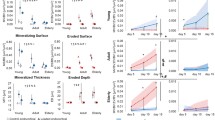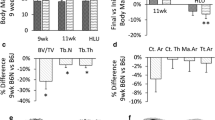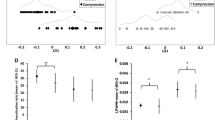Abstract.
We investigated the bone response to external loading in C57BL/6J and C3H/HeJ mice, both breeds with low and high bone density, respectively. An in vivo tibial four-point bending device previously used for application of measured external loads in rats was adapted for mice. It delivered a uniform medio-lateral bending moment to the region of the tibia located 1–5.5 mm proximal to the tibio-fibula junction. The right legs of six C57BL/6J [low bone density (LBD)] and C3H/HeJ [high bone density (HBD)] mice were externally loaded in the device for 36 cycles/day at 2 Hz, 6 days/week for 2 weeks at 9.3 ± 0.9 N force, inducing estimated lateral periosteal surface compressive strains of 5121 ± 1128 με in C3H/HeJ (HBD) mice (n = 6), significantly higher than the estimated 3988 ± 820 με in C57BL/6J mice (n = 6) (mean ± SD). In addition, C3H/HeJ HBD mice (n = 11) were externally sham (pad pressure or no bending) loaded in the device for 36 cycles/day at 2 Hz, 3 days/week for 3 weeks at 9.3 ± 0.9 N force. Calcein injections for bone labeling were given at the 10th and 3rd days before sacrifice. At the end of the experiment, all mice were killed and both tibiae were removed, fixed, embedded, and cross-sectioned through the loaded region. Both tibiae were measured for marrow area (Ma.Ar), cortical area (Ct.Ar), total area (Tt.Ar), cross-sectional moment of inertia (CSMI), and periosteal and endocortical woven bone surface (Wo.B/BS), single-labeled surface (sLS), double-labeled surface (dLS), and total formation surface (FS/BS). Differences in all variables due to breed and loading (both bending and sham-bending) were tested by two-way analysis of variance (ANOVA) (P < 0.05). Ma.Ar, Tt.Ar, and CSMI were greater in C57BL/6J (LBD) than in C3H/HeJ (HBD) mice. Periosteal and endocortical woven bone and formation surface were increased significantly more by loading (bending) in C57BL/6J than in C3H/HeJ mice. Periosteal woven bone response due to sham-bending or sham-loading was significantly lower than due to bending loads in the C3H/HeJ mice. We conclude that the bone response to external loading is greater in LBD mice than in HBD mice. The high bone density of C3H/HeJ (HBD) mice is related to breed-specific factors other than the response to loading.
Similar content being viewed by others
Author information
Authors and Affiliations
Additional information
Received: 5 March 1997 / Accepted: 8 April 1998
Rights and permissions
About this article
Cite this article
Akhter, M., Cullen, D., Pedersen, E. et al. Bone Response to In Vivo Mechanical Loading in Two Breeds of Mice. Calcif Tissue Int 63, 442–449 (1998). https://doi.org/10.1007/s002239900554
Published:
Issue Date:
DOI: https://doi.org/10.1007/s002239900554




